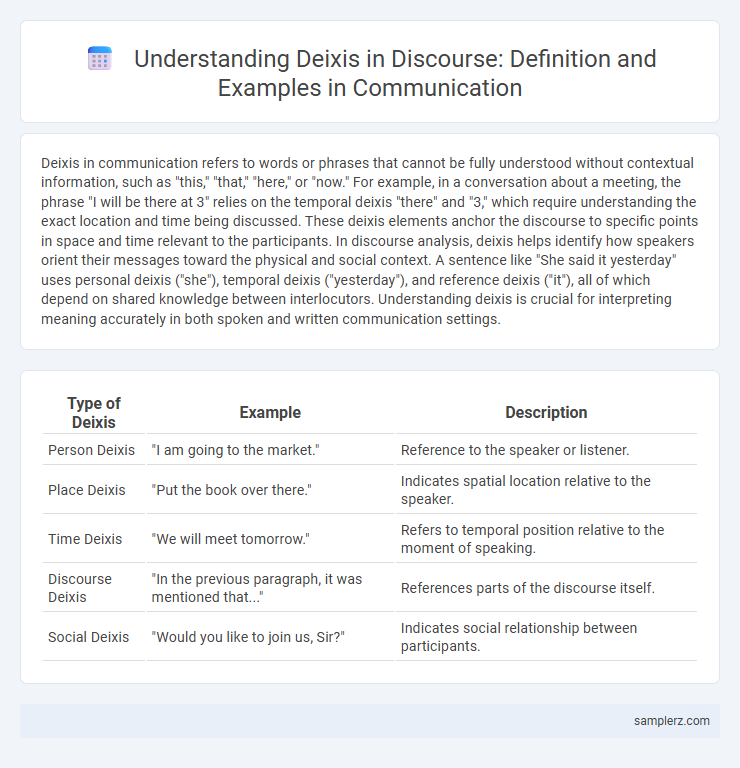Deixis in communication refers to words or phrases that cannot be fully understood without contextual information, such as "this," "that," "here," or "now." For example, in a conversation about a meeting, the phrase "I will be there at 3" relies on the temporal deixis "there" and "3," which require understanding the exact location and time being discussed. These deixis elements anchor the discourse to specific points in space and time relevant to the participants. In discourse analysis, deixis helps identify how speakers orient their messages toward the physical and social context. A sentence like "She said it yesterday" uses personal deixis ("she"), temporal deixis ("yesterday"), and reference deixis ("it"), all of which depend on shared knowledge between interlocutors. Understanding deixis is crucial for interpreting meaning accurately in both spoken and written communication settings.
Table of Comparison
| Type of Deixis | Example | Description |
|---|---|---|
| Person Deixis | "I am going to the market." | Reference to the speaker or listener. |
| Place Deixis | "Put the book over there." | Indicates spatial location relative to the speaker. |
| Time Deixis | "We will meet tomorrow." | Refers to temporal position relative to the moment of speaking. |
| Discourse Deixis | "In the previous paragraph, it was mentioned that..." | References parts of the discourse itself. |
| Social Deixis | "Would you like to join us, Sir?" | Indicates social relationship between participants. |
Introduction to Deixis in Discourse
Deixis in discourse refers to the use of words or phrases, such as "this," "that," "here," and "now," which rely on contextual information to convey meaning. For example, in the sentence "Put it there," the words "it" and "there" require knowledge of the speaker's location and the objects involved to understand the intended referents. These deictic expressions anchor the communication to specific points in time, space, or person, making them essential for effective interaction.
Types of Deixis and Their Functions
Deixis in communication involves words and phrases that require contextual information to be fully understood, such as personal, spatial, and temporal deixis. Personal deixis refers to pronouns like "I," "you," and "they," which identify participants in the discourse. Spatial deixis includes terms like "here" and "there," indicating physical locations relative to the speaker, while temporal deixis involves expressions such as "now," "then," and "soon," marking time references crucial for interpreting the message accurately.
Personal Deixis: Referencing Participants
Personal deixis in communication involves using pronouns like "I," "you," and "we" to reference participants within a discourse context, establishing speaker and listener roles. For example, in the sentence "I will help you with your project," "I" refers to the speaker, and "you" designates the listener, grounding meaning in the interaction. This deixis crucially depends on the situational context, as the referents of personal pronouns shift with changes in speaker and addressee roles across different conversations.
Spatial Deixis: Indicating Location
Spatial deixis in communication involves words or phrases that indicate location relative to the speaker, such as "here," "there," "this," and "that." For example, in the sentence "Put the book over there," the term "there" directly points to a specific place understood within the discourse context. This usage helps listeners identify spatial relationships crucial for effective interaction and understanding.
Temporal Deixis: Expressing Time in Communication
Temporal deixis anchors communication by referencing time through expressions like "yesterday," "now," and "tomorrow," which require contextual interpretation based on the speaker's present moment. These temporal indicators enable interlocutors to situate events relative to the current time frame, facilitating coherent understanding in discourse. Effective use of temporal deixis enhances clarity in storytelling, scheduling, and narrative sequencing within diverse communicative interactions.
Discourse Deixis: Referring within Text
Discourse deixis involves using expressions like "this," "that," "here," and "there" to refer to parts of the ongoing text, helping listeners or readers track and interpret information within communication. For example, in a conversation, phrases such as "this point," "that idea," or "as mentioned earlier" direct attention to previously stated segments, enhancing coherence and understanding. Effective use of discourse deixis creates clear connections between sentences, facilitating smooth information flow in spoken or written discourse.
Social Deixis: Signaling Social Relationships
Social deixis in discourse primarily signals social relationships by indicating status, roles, or levels of politeness through pronouns, honorifics, and forms of address. For example, the use of "sir" or "ma'am" conveys respect and social hierarchy, while choosing between "tu" and "vous" in French denotes familiarity or formality. These linguistic choices guide interpersonal dynamics and reflect social context in communication.
Deictic Expressions in Everyday Conversation
Deictic expressions such as "this," "that," "here," and "now" play a crucial role in everyday conversation by anchoring meaning to the context of the speaker and listener. These deictic terms depend on spatial, temporal, and personal reference points, allowing interlocutors to efficiently convey information without explicit detail. Understanding deixis enhances communicative clarity and aids in interpreting utterances relative to the conversational setting.
Challenges and Ambiguities of Deixis in Discourse
Deixis in discourse often creates challenges due to its reliance on context, where words like "this," "that," and "here" can generate ambiguity without shared situational knowledge. Ambiguities arise when interlocutors lack common temporal, spatial, or personal reference points, complicating interpretation and communication efficiency. Effective resolution depends on explicit contextual cues and pragmatic strategies to clarify deictic expressions within conversations.
Conclusion: The Importance of Deixis in Effective Communication
Deixis plays a crucial role in effective communication by anchoring utterances to specific contextual elements such as time, place, and participants, thereby enabling clear understanding. Pronouns like "this," "that," and temporal expressions such as "now" or "then" function as deictic markers that guide interlocutors in interpreting meaning relative to the communicative context. Accurate use of deixis fosters coherence and reduces ambiguity, which is essential for successful discourse and pragmatic comprehension.

example of deixis in discourse Infographic
 samplerz.com
samplerz.com